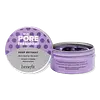What's inside
What's inside
 Key Ingredients
Key Ingredients

 Benefits
Benefits

 Concerns
Concerns

 Ingredients Side-by-side
Ingredients Side-by-side

Solanum Lycopersicum Fruit Extract
AntioxidantMyristic Acid
CleansingGlycerin
HumectantBentonite
AbsorbentKaolin
AbrasivePotassium Hydroxide
BufferingLauric Acid
CleansingTitanium Dioxide
Cosmetic ColorantZea Mays Starch
AbsorbentPalmitic Acid
EmollientButylene Glycol
HumectantStearic Acid
CleansingCoco-Glucoside
Cleansing1,2-Hexanediol
Skin ConditioningCentella Asiatica Extract
CleansingFicus Carica Fruit Extract
HumectantOenothera Biennis Flower Extract
AstringentUlmus Davidiana Root Extract
Skin ConditioningPinus Palustris Leaf Extract
TonicPueraria Lobata Root Extract
HumectantHydrogenated Lecithin
EmulsifyingMagnesium Aluminum Silicate
AbsorbentWater
Skin ConditioningMentha Arvensis Powder
MaskingHydroxyacetophenone
AntioxidantGlyceryl Stearate
EmollientDipropylene Glycol
HumectantEthylhexylglycerin
Skin ConditioningDecylene Glycol
Skin ConditioningSodium Cocoyl Glycinate
CleansingSodium Phytate
Beta-Glucan
Skin ConditioningCeramide NP
Skin ConditioningMontmorillonite
AbsorbentIllite
AbrasiveCanadian Colloidal Clay
Skin ConditioningHectorite
AbsorbentChromium Oxide Greens
Solanum Lycopersicum Fruit Extract, Myristic Acid, Glycerin, Bentonite, Kaolin, Potassium Hydroxide, Lauric Acid, Titanium Dioxide, Zea Mays Starch, Palmitic Acid, Butylene Glycol, Stearic Acid, Coco-Glucoside, 1,2-Hexanediol, Centella Asiatica Extract, Ficus Carica Fruit Extract, Oenothera Biennis Flower Extract, Ulmus Davidiana Root Extract, Pinus Palustris Leaf Extract, Pueraria Lobata Root Extract, Hydrogenated Lecithin, Magnesium Aluminum Silicate, Water, Mentha Arvensis Powder, Hydroxyacetophenone, Glyceryl Stearate, Dipropylene Glycol, Ethylhexylglycerin, Decylene Glycol, Sodium Cocoyl Glycinate, Sodium Phytate, Beta-Glucan, Ceramide NP, Montmorillonite, Illite, Canadian Colloidal Clay, Hectorite, Chromium Oxide Greens
Water
Skin ConditioningKaolin
AbrasiveSilica
AbrasiveGlycerin
HumectantButylene Glycol
HumectantPentylene Glycol
Skin ConditioningCI 77007
Cosmetic ColorantPEG-40 Sorbitan Peroleate
EmulsifyingSodium Acrylates Copolymer
Caprylic/Capric Triglyceride
MaskingCI 77499
Cosmetic ColorantHydroxyacetophenone
AntioxidantLecithin
EmollientMica
Cosmetic ColorantChlorphenesin
AntimicrobialBisabolol
MaskingCI 77491
Cosmetic ColorantHydrogenated Vegetable Oil
EmollientOpuntia Coccinellifera Flower Extract
Skin ConditioningCI 77891
Cosmetic ColorantTrisodium Ethylenediamine Disuccinate
Simmondsia Chinensis Seed Oil
EmollientPrunus Domestica Seed Oil
Skin ConditioningParfum
MaskingDisodium Phosphate
BufferingPotassium Hydroxide
BufferingXanthan Gum
EmulsifyingCrithmum Maritimum Extract
Skin Conditioning1,2-Hexanediol
Skin ConditioningCaprylyl Glycol
EmollientTocopherol
AntioxidantCI 77510
Cosmetic ColorantSodium Phosphate
BufferingSphingolipids
EmollientSphingomonas Ferment Extract
Skin ConditioningTocopheryl Acetate
AntioxidantCitric Acid
BufferingPentaerythrityl Tetra-Di-T-Butyl Hydroxyhydrocinnamate
AntioxidantSodium Citrate
BufferingWater, Kaolin, Silica, Glycerin, Butylene Glycol, Pentylene Glycol, CI 77007, PEG-40 Sorbitan Peroleate, Sodium Acrylates Copolymer, Caprylic/Capric Triglyceride, CI 77499, Hydroxyacetophenone, Lecithin, Mica, Chlorphenesin, Bisabolol, CI 77491, Hydrogenated Vegetable Oil, Opuntia Coccinellifera Flower Extract, CI 77891, Trisodium Ethylenediamine Disuccinate, Simmondsia Chinensis Seed Oil, Prunus Domestica Seed Oil, Parfum, Disodium Phosphate, Potassium Hydroxide, Xanthan Gum, Crithmum Maritimum Extract, 1,2-Hexanediol, Caprylyl Glycol, Tocopherol, CI 77510, Sodium Phosphate, Sphingolipids, Sphingomonas Ferment Extract, Tocopheryl Acetate, Citric Acid, Pentaerythrityl Tetra-Di-T-Butyl Hydroxyhydrocinnamate, Sodium Citrate
 Reviews
Reviews

Ingredients Explained
These ingredients are found in both products.
Ingredients higher up in an ingredient list are typically present in a larger amount.
1,2-Hexanediol is a synthetic liquid and another multi-functional powerhouse.
It is a:
- Humectant, drawing moisture into the skin
- Emollient, helping to soften skin
- Solvent, dispersing and stabilizing formulas
- Preservative booster, enhancing the antimicrobial activity of other preservatives
Butylene Glycol (or BG) is used within cosmetic products for a few different reasons:
Overall, Butylene Glycol is a safe and well-rounded ingredient that works well with other ingredients.
Though this ingredient works well with most skin types, some people with sensitive skin may experience a reaction such as allergic rashes, closed comedones, or itchiness.
Learn more about Butylene GlycolGlycerin is already naturally found in your skin. It helps moisturize and protect your skin.
A study from 2016 found glycerin to be more effective as a humectant than AHAs and hyaluronic acid.
As a humectant, it helps the skin stay hydrated by pulling moisture to your skin. The low molecular weight of glycerin allows it to pull moisture into the deeper layers of your skin.
Hydrated skin improves your skin barrier; Your skin barrier helps protect against irritants and bacteria.
Glycerin has also been found to have antimicrobial and antiviral properties. Due to these properties, glycerin is often used in wound and burn treatments.
In cosmetics, glycerin is usually derived from plants such as soybean or palm. However, it can also be sourced from animals, such as tallow or animal fat.
This ingredient is organic, colorless, odorless, and non-toxic.
Glycerin is the name for this ingredient in American English. British English uses Glycerol/Glycerine.
Learn more about GlycerinHydroxyacetophenone is antioxidant with skin conditioning and soothing properties. It also boosts the efficiency of preservatives.
This ingredient is not irritating or sensitizing.
Kaolin is a clay. It is used for oil control and to help minimize pores. Like other clays, kaolin has the ability to absorb excess sebum or oil. This can help clean out pores and mattify the skin.
Some types of kaolin may have exfoliating properties. When water is added to kaolin, it becomes a paste with small abrasive particles.
Most kaolin is a white color, but may be pink/orange/red depending on where it comes from.
The name 'kaolin' comes from a Chinese village named 'Gaoling'. Kaolin clay comes from rocks rich in kaolinite. Kaolinite, the mineral, has a silicate layered structure. Kaolinite is formed from chemical weathering of aluminum siilicate minerals.
Besides skincare, kaolin is commonly used to make glossy paper, in ceramics, toothpaste, and as medicine to soothe stomach issues.
Learn more about KaolinPotassium hydroxide is commonly known as caustic potash. It is used to fix the pH of a product or as a cleaning agent in soap. In cleansers, it is used for the saponification of oils.
Sapnification is the process of creating fatty acid metal salts from triglycerides and a strong base. During this process, Potassium Hydroxide is used up and is not present in the final product.
Using high concentrations of Potassium Hydroxide have shown to irritate the skin.
Learn more about Potassium HydroxideWater. It's the most common cosmetic ingredient of all. You'll usually see it at the top of ingredient lists, meaning that it makes up the largest part of the product.
So why is it so popular? Water most often acts as a solvent - this means that it helps dissolve other ingredients into the formulation.
You'll also recognize water as that liquid we all need to stay alive. If you see this, drink a glass of water. Stay hydrated!
Learn more about Water